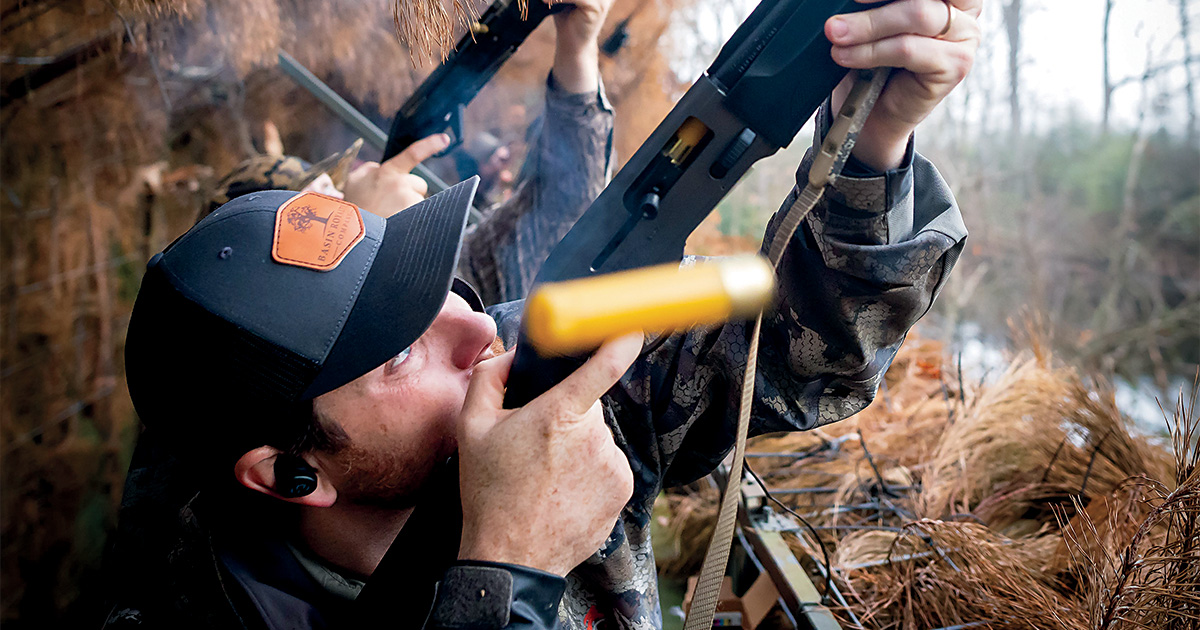Shotgunning: Shooting from Blinds
How to quickly and safely make the transition from hiding to shooting
How to quickly and safely make the transition from hiding to shooting

When the shot is called, hunters should work as a team by staying within their own shooting lanes, which are typically located in the 10-to-2 window directly in front of their positions in the blind.
If you’re not hiding, the waterfowler’s saying goes, you’re not shooting. But concealing yourself in a blind can make shooting difficult. The following strategies will increase your chances for success and keep you safe whether you’re tucked into a pit below ground, on your back in a layout blind, or crowded into an A-frame or box blind.
Before the hunt starts, take some time to settle in the blind and stow your gear. Be sure that everything is in place and easy to reach, and that there’s nothing underfoot that might cause you to slip. Be especially careful where you set your ammunition. There may be shells of several different gauges in the blind, and you don’t want to mix them up in the excitement of a fast reload.
Leave your gun unloaded until shooting time. If the blind is heavily brushed, take the sling off your gun so it won’t tangle in brush when you shoot. Stand or sit up to familiarize yourself with the 10-to-2 window where you’ll take your shots. If there are retrievers along, remind yourself to not take low shots, and that goes double for pits and layouts. A breaking dog can bolt in front of your muzzle before you know it.
Try to angle layout blinds so that any shots will come at a shooter’s natural point of aim. For right-handed shooters this is about 11:00; for lefties it’s about 1:00. That way, if the birds do what they’re supposed to, you’ll sit up and have a shot that doesn’t require twisting around. It’s much easier for right-handed shooters to swing to the left than to the right and vice versa. If there’s a lefty in the group, put him or her on the right end, where he or she can shoot the birds that fly to that side.
As ducks or geese approach, get your hands on your gun. While keeping your head down, try to watch the birds working so you’ll know what to expect when the shot is called. If you can’t see, as is the case in many pits and some other blinds, listen to the shot caller, who should be giving a running commentary on what the birds are doing.
When it’s time to shoot, tell yourself to get up in a hurry, then slow down. If birds have committed to the decoys, they don’t know you’re there. You’ll have an instant before they begin to flare. It’s tempting to rush, but settle yourself down, pick a bird, and really look at it. If it’s close, focus on the head or the bill. After standing or sitting up, your first move is to push the gun out and toward the bird. Pushing the gun out helps you clear any bulky clothing without snagging, and it gets the muzzle moving to the target. As you move the muzzle toward the bird, raise the stock to your face and the butt to your shoulder pocket. A smooth mount is just as fast as a rushed mount because it’s a more efficient move.
When you shoot a bird, stay with it until it’s down and you know it’s dead. Be sure there are no dogs in your line of fire before you shoot at crippled birds. Better yet, let the dog’s owner shoot any birds on the water, or ask before you do.
If you have a chance to shoot a bird over the top, or on the end, say something first, or ask the blind boss: “Okay if I take this one?” This helps avoid situations where more than one person pops up unannounced to take the shot or, worse, one person stands to shoot and another shoots sitting down next to him.
If someone goes out in front of the blind, point your muzzle up. If you leave the blind, unload your gun or take it with you. Always unload it before you set it down. After each volley, check your area of the blind for empties and pick them up. This will help keep your footing safe so you won’t risk stumbling when the next bunch comes in.
Ducks Unlimited uses cookies to enhance your browsing experience, optimize site functionality, analyze traffic, and deliver personalized advertising through third parties. By continuing to use this site, you agree to our use of cookies. View Privacy Policy